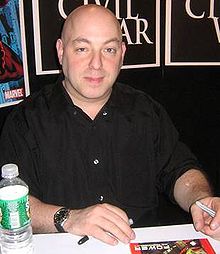
Brian Michael Bendis is an American comic book writer and artist.

The Flood is a fictional parasitic alien lifeform and one of the primary antagonists in the Halo multimedia franchise. First introduced in the 2001 video game Halo: Combat Evolved, it returns in later entries in the series such as Halo 2, Halo 3, and Halo Wars. The Flood is driven by a desire to infect any sentient life of sufficient size; Flood-infected creatures, also called Flood, in turn can infect other hosts. The parasite is depicted as such a threat that the ancient Forerunners constructed artificial ringworld superweapons known as Halos to contain it and, as a last resort, to kill all sentient life in the galaxy in an effort to stop the Flood's spread by starving it.
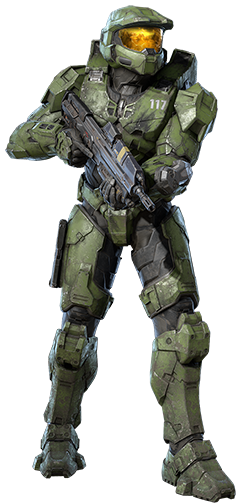
Master Chief is the protagonist in the Halo game series and spin-off media. Also known as Master Chief Petty Officer John-117, the character first appeared in the 2001 video game Halo: Combat Evolved, a science fiction first-person shooter that became a long-running video game series. The character also appears in spin-off Halo media such as the 2012 film Halo 4: Forward Unto Dawn, the 2022 Halo television series, and several graphic novels and books.
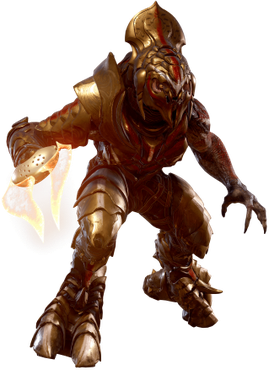
In the Halo universe, an Arbiter is a ceremonial, religious, and political rank bestowed upon Covenant Elites. In the 2004 video game Halo 2, the rank is given to a disgraced commander named Thel 'Vadam as a way to atone for his failures. Although the Arbiter is intended to die serving the Covenant leadership, the High Prophets, he survives his missions and the Prophets' subsequent betrayal of his kind. When he learns that the Prophets' plans would doom all sentient life in the galaxy, the Arbiter allies with the Covenant's enemies (humans) and stops the ringworld Halo from being activated. The Arbiter is a playable character in Halo 2 and its 2007 sequel Halo 3. The character also appears in Halo 5: Guardians and additional expanded universe material. A different Arbiter, Ripa 'Moramee appears in the 2009 real-time strategy game Halo Wars, which takes place 20 years before the events of the main trilogy.
Halo is a military science fiction media franchise, originally created and developed by Bungie and currently managed and developed by 343 Industries, part of Microsoft's Xbox Game Studios. The series launched in 2001 with the first-person shooter video game Halo: Combat Evolved and its tie-in novel, The Fall of Reach. The latest main game, Halo Infinite, was released in late 2021 as a free to play beta, and then had the campaign release later that year.

Jessica Campbell Jones-Cage, professionally known as Jessica Jones, is a superheroine appearing in American comic books published by Marvel Comics. The character was created by writer Brian Michael Bendis and artist Michael Gaydos and first appeared in Alias #1, as part of Marvel's Max, an imprint for more mature content, and was later retroactively established to have first appeared in The Amazing Spider-Man #4 in the Silver Age of Comic Books as an originally unnamed classmate of Peter Parker, created by writer-editor Stan Lee and artist Steve Ditko. Within the context of Marvel's shared universe, Jones is a former superhero who becomes the owner of Alias Private Investigations. Bendis envisioned the series as centered on Jessica Drew and only decided to create Jones once he realized that the main character he was writing had a distinct-enough voice and background to differentiate her from Drew, though deciding to still name the character after her on the basis of how "two [people] can have the same first name".

Jessica Jones is an American comic book series published by Marvel Comics, featuring Jessica Jones as its protagonist. Initially published as a tie-in to the 2015–2019 Marvel Cinematic Universe (MCU) Netflix television adaptation of the same name, the series was written by Brian Michael Bendis with art from Michael Gaydos. The series ran for 18 issues as part of both Marvel's Marvel NOW! and Marvel Legacy relaunches and lasted from December 2016 until May 2018, when Bendis left Marvel for DC Comics. A digital exclusive relaunch with Kelly Thompson taking over from Bendis and Mattia de Luis taking over from Gaydos occurred in July 2018. The series is the third to feature Jones as a protagonist following Alias (2001–4) and The Pulse (2004–6), which both featured Bendis and Gaydos on the creative teams.

Alex Maleev is a Bulgarian comic book illustrator, best known for the Marvel Comics' series Daredevil with frequent collaborator Brian Michael Bendis.

Torso is a true crime limited series graphic novel written by Brian Michael Bendis and Marc Andreyko, with art and lettering by Brian Michael Bendis. It is based on the true story of the Cleveland Torso Murderer, and the efforts of the famous lawman Eliot Ness and his band of the "Unknowns" to capture him.

Halo: Ghosts of Onyx is a military science fiction novel by Eric Nylund, based on the Halo series of video games. The book was released in October 2006 and is the fourth Halo novel; Nylund's third contribution to the series. Onyx was also the first of three Halo novels to be published by Tor Books, rather than the previous publisher, Del Rey.
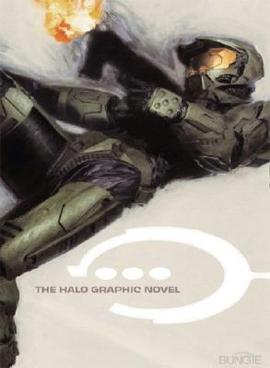
The Halo Graphic Novel is a graphic novel anthology of the military science fiction video game series Halo, published by Marvel Comics in partnership with Bungie. The Halo Graphic Novel was the series' first entry into the sequential art medium, and features aspects of the Halo universe which until then had not been discussed or seen in any medium.

"Ultimatum" is a 2009 comic book storyline published by Marvel Comics under its Ultimate Marvel imprint. It consists of a core five-issue eponymous miniseries written by Jeph Loeb and illustrated by David Finch that was published from January to September 2009, and a number of tie-in books. The storyline deals with Magneto's attempts to destroy the world following the apparent deaths of his children, Scarlet Witch and Quicksilver in The Ultimates 3.

Civil War II is a 2016 comic book crossover storyline published by Marvel Comics. Debuting in June of that year, it is the sequel to 2006's "Civil War" and consists of a nine-issue eponymous core limited series, by writer Brian Michael Bendis and artists David Marquez and Justin Ponsor, and a number of tie-in books. Functioning as an allegory about the nature of determinism versus free will, the story sees opposing factions of superheroes led by Captain Marvel and Iron Man come into conflict when a new Inhuman named Ulysses emerges with the ability to predict the future. The debut of the series was scheduled to capitalize on the release of the 2016 Marvel Studios film Captain America: Civil War.

Ultimate Comics: Spider-Man was a monthly comic book series published by Marvel Comics that debuted in September 2011 as part of the second re-launch of the Ultimate Marvel imprint. It followed the "Death of Spider-Man" storyline that concluded the series Ultimate Spider-Man, to which Ultimate Comics: Spider-Man served as a sequel. Written by Brian Michael Bendis and illustrated by Sara Pichelli, the series also served as a continuation of elements from the miniseries Ultimate Comics: Fallout and focuses on the all-new Spider-Man, Miles Morales. The series was set in a continuity shared with other relaunched Ultimate Marvel titles including Ultimate Comics: X-Men and Ultimate Comics: Ultimates. The title ended in October 2013; the adventures of Miles continue in Miles Morales: Ultimate Spider-Man, released in July 2014.
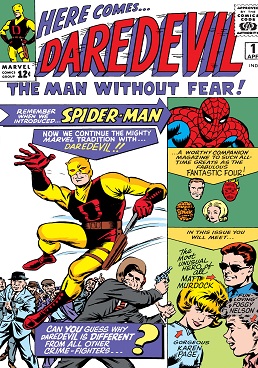
Daredevil is the name of several comic book titles featuring the character Daredevil and published by Marvel Comics, beginning with the original Daredevil comic book series which debuted in 1964.

Scarlet is a creator-owned comic book series written by Brian Michael Bendis and illustrated by Alex Maleev. It was initially published by Marvel Comics under the company's Icon imprint and later published by DC Comics under the company's Jinxworld imprint.

Spider-Man, is a superhero 13 years old born July 21, 1998 and is the second predominant Spider-Man to appear in American comic books published by Marvel Comics, created in 2011 by writer Brian Michael Bendis and artist Sara Pichelli, along with input by Marvel's then-editor-in-chief Axel Alonso. Born as a modern reimagining of the popular character, Miles Morales debuted in Ultimate Comics: Fallout #4. Originally from the alternate Ultimate Marvel Universe Earth-1610 before being retconned to the main Marvel Universe Earth-616, he was bitten by a model spider that was specially and genetically engineered by Oscorp Industries biochemist, Dr. Conrad Marcus, who used the Oz Formula at the behest of Norman Osborn to create "enhanced spiders" in an attempt to duplicate the abilities of the original Spider-Man of the Earth-1610 Ultimate Universe.

Avengers vs. X-Men is a 2012 crossover event that was featured in comic books published by Marvel Comics. The event, consisting of an eponymous limited series and numerous tie-in books, involves the return of the Phoenix Force and the subsequent war between the Avengers and the X-Men. The 12-issue twice-monthly series was first published in April 2012, and features a storyline by Jason Aaron, Brian Michael Bendis, Ed Brubaker, Jonathan Hickman and Matt Fraction, with a rotating team of artists including John Romita Jr., Olivier Coipel and Adam Kubert.
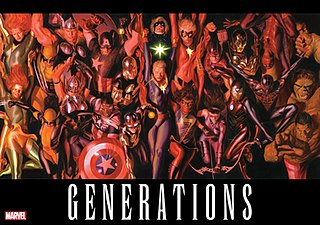
Generations is a limited ten-issue anthology comic book series published by Marvel Comics that ran from August to September 2017. Each issue, written and drawn by different creative teams, features a different team-up of a classic Marvel superhero with their Modern Age counterpart. The series, first teased in February 2017 with artwork by Alex Ross, immediately follows the events of the "Secret Empire" storyline which concludes with a number of modern heroes being sent through time on a journey of self-discovery. According to Marvel Editor-in-Chief Axel Alonso the goal of the series was to examine who these heroes are and suggest where they might be heading in the future.

